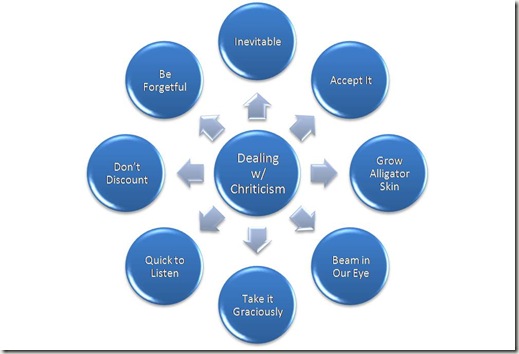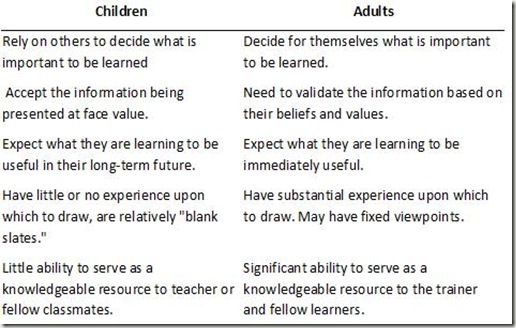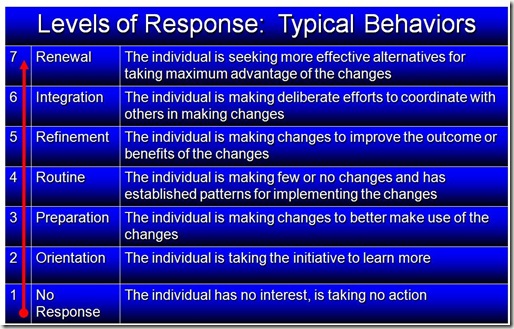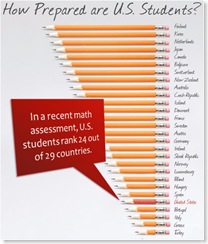(Reposted from Google Blogger)
Dr. Barrett Mosbacker, PublisherI recently read an interesting article by the CEO of Yahoo! titled The Peanut Butter Manifesto. Click here to read the memo. I highly recommend it to you.
For the purposes of this blog article I want to focus on the following statement from the memo because it is instructive for us as school leaders.
"We lack a focused, cohesive vision for our company. We want to do everything and be
everything -- to everyone. We've known this for years, talk about it incessantly, but do nothing to fundamentally address it. We are scared to be left out. We are reactive instead of charting an unwavering course. We are separated into silos that far too frequently don't talk to each other. And when we do talk, it isn't to collaborate on a clearly focused strategy, but rather to argue and fight about ownership, strategies and tactics ...
I've heard our strategy described as spreading peanut butter across the myriad opportunities that continue to evolve in the online world. The result: a thin layer of investment spread across everything we do and thus we focus on nothing in particular."
Spread Too Thin: Strategic Allocation of Limited Resources
The Christian school movement is not particularly healthy. Based on recent statistics that I have seen, the number of Christian schools and overall school enrollments are stagnant or declining.
Although there are external forces beyond our control that affect our schools, many of our problems are self-inflicted. One of our self-inflicted wounds is similar to that articulated by the CEO of Yahoo!--we are often not strategic in the allocation of our tangible and intangible resources and as a consequence we are not offering a substantial marginal value to our current and potential clients. I am referring to our parents a clients because notwithstanding our missions as Christian schools, our parents are essentially paying clients who make economic calculations in deciding whether to enroll or re-enroll their children in our schools.
School Finance 101
If there is one unalterable truth about school resource management, it is this: the laws of economics do not discriminate. The laws of economics apply equally to both religious and non-religious institutions, regardless of their mission. The laws of economics are not religious.
Economic laws, like physical laws, apply universally to all regardless of one’s religion, one’s motives, or one’s hopes and dreams. Economic laws can no more be circumvented than the law of gravity because the laws of economics are as much a creation of God as the laws of physics.
The laws of economics are the laws of God. They are in the same way that the laws of physics are the laws of God … They are the laws of God because it is He that decrees the existence of the entities whose nature it is to obey those laws: had He wanted other laws He would have had to create other things ….Like physical laws they are necessary but only hypothetically necessary. They work positis ponendis. In other words, these laws are formulated in terms of “if then” statements. Economic laws do not tell us what human beings will or will not do, how they will behave, [nor how they ought to be behave]. They tell us rather what will happen if human beings behave in certain ways.... [Emphasis added] (Sadowsky, 2005, p. 3)
Assuming that God will suspend the laws of economics because the school is a ministry, too many Christian school leaders believe they can violate those laws with impunity. With the best of intentions, usually with the goal of making Christian education affordable for everyone, many administrators and boards establish financial policies that violate basic economic principles, good business practices, and common sense.
School leaders have a responsibility to understand and to apply economic laws and sound financial practices to the management of their schools. Failure to do so is a failure to apply the very biblical worldview to school management that is its raison d'être.
The Cost of Excellence
A basic law of economics is that for an organization to survive, let alone thrive, its revenue must equal or exceed its costs. This is just as true for “Pearly Gates Christian School” as it is for IBM. Common sense enough but it is surprising how many intelligent people violate this basic axiom of economics when filling a leadership role in the Christian school. Motivated by the laudable desire to provide a Christian education to as many children as possible, many school leaders abandon common sense. Sadly, such well-meaning intentions threaten the survival of the very ministry they so earnestly believe in.
Artificially low tuition is one example of violating basic economic law. Yet many administrators and boards routinely establish tuition rates below the actual cost to educate and compound the problem by providing multi-child and vocationally-based tuition discounts regardless of parents’ ability to pay. With inadequate revenue, programs are often under funded, limited, and of mediocre quality. Shallow fine arts programs, out-dated and/or underutilized technology, limited foreign language offerings, and limited or non-existent programs for gifted and special needs students are common.
Providing a world-class Christian education cannot be done on the cheap, it is expensive. According to the NCES (2004a), expenditures for public and private education were estimated at $866 billion for 2003–04. Expenditures for elementary and secondary schools alone were estimated to total $514 billion.
Public school per pupil expenditures for the 2001-02 school year averaged $8,259. By comparison, tuition per pupil in ACSI member schools in the same year averaged $4,642, a difference of $3,617/student .
This 44% differential is “funded” by paying below market compensation, through fundraising and/or church subsidies, by offering programs of limited scope and marginal quality, and/or by incurring debt.
Many Christian schoolteachers bear the burden of subsidizing below cost tuition rates through low salaries and poor benefits. Sixty-eight percent of teachers employed in ACSI member schools with at least 10 years of experience earn less than $30,000 per year, (Association of Christian Schools International, 2005). By contrast, statistics from the NCES (2002) show that the average starting salary for teachers with no experience in public charter schools that used a salary schedule was $26,977, compared with $25,888 for public school districts.
Education is a labor-intensive enterprise with labor costs typically representing 65 to 80 percent of a school’s entire operating costs, (William J. Fowler & Monk, 2001). The combination of below cost tuition and high labor costs results in artificially depressed salary levels making staffing the school with highly trained and competent teachers throughout the program difficult, especially at the secondary level.
Low salaries and poor benefits often produce high staff turnover creating discontinuity in the academic program. The applicant pool is small, forcing the administrator to hire the “best available” from a pool of relatively mediocre teachers. The result is poor to average instructional and academic quality, the loss of parental confidence, low student retention rates, especially at the upper school level, and a reputation for mediocre quality.
Many Christian leaders find themselves caught in a vicious and self-defeating cycle. Under funding produces poor quality, which in turn restricts enrollment levels and school revenue. To increase revenue, school leadership needs to raise tuition rates but many current and prospective parents do not believe that the school’s quality justifies the higher cost. Parents choose to leave or not to enroll their children in the school in the first place. In a desperate attempt to stem the loss of students or to stimulate enrollment, tuition continues to be set below actual cost thus perpetuating the cycle.
Supply and Demand
The theory of supply and demand is one of the most basic in economics. Simply stated, supply is the amount of product or service that a business or organization is willing or able to provide at a specified price. Demand is the amount of product or service that a consumer is willing to buy at a specified price, (International Society for Complexity Information and Design, n.d.). Modifying this definition for the Christian school market, the definition may read as follows; supply is the quality of education that a Christian school can provide at a specified tuition level while demand is the amount of tuition that parents are willing to pay for the perceived value of the education provided. Everything else being equal, demand (enrollment) will be strong when the market (parents) believe that the school provides a quality of education valued at equal to or above the tuition charged. If enrollment is stagnant or declining this is a sign that the market does not perceive the value offered to be equal to the tuition charged.
Common sense enough, but things are a bit more complex than the foregoing definition implies. To grasp more fully the economics of Christian schooling, two other economic principles need to be considered; price elasticity of demand and marginal value. Relax; this is not as bad as it sounds!
Elasticity refers to market sensitivity to price changes. Demand for very price elastic products or services will vary significantly based on price. Relatively small increases or decreases in price will have a significant impact on demand. On the other hand, demand for products and services that are price inelastic is relatively stable even with relatively wide swings in price. For example, farmers face a relatively inelastic market; modest increases or decreases in groceries have only a modest affect on consumer demand for staples. However, airfares are elastic; even slight price increases or decreases in airfare can dramatically affect ticket sales.
There are several factors that affect elasticity of demand (QuickMBA, 2004):
· Availability of substitutes, the more possible substitutes, the greater the elasticity,
· Degree of necessity or luxury: luxury products tend to have greater elasticity. Some products that initially have a low degree of necessity are habit forming and can become "necessities" to some consumers, e.g., the microwave and the cell phone.
· Proportion of the purchaser's budget consumed by the item: products that consume a large portion of the purchaser's budget tend to have greater elasticity.
For the Christian school this means that, other factors being constant, the availability of schooling options in the community will affect the administration’s ability to increase enrollments and what can be charged for tuition. The more options, the more elastic tuition rates will be. Likewise, the fewer alternatives that parents have, the less elastic tuition will be.
The quality of alternative educational options will also affect tuition elasticity. If area public and private schools are considered poor relative to the local Christian school, enrollment in the Christian school may be perceived as more of a necessity than it will be if the community is blessed with a large number of high quality public and private schools. In the latter case, parents have a smorgasbord of quality educational options. If parents perceive the local public schools to be safe, high quality learning environments, they are more likely to consider enrollment in the Christian school to be a discretionary “luxury” purchase. Only the most diehard adherents to a Christian philosophy of education will consider enrollment in the Christian school a necessity. If on the other hand, local schools are perceived to be unsafe and of poor quality, “purchasing” a Christian education is more likely to be considered a necessity, making tuition levels less elastic.
The Archdiocese of Chicago provides a compelling example of this principle. Faced with declining enrollments and a school deficit of $20 million, the Archdiocese commissioned a study to determine how to boost school enrollment. Boffetti (n.d.) reports that researchers discovered that:
Struggling schools, at the very least, needed to fill every available seat with tuition-paying students. Surprisingly, many inner-city parents, both Catholic and non-Catholic alike, did not know that Catholic education would only cost them $1,000 a year, with the diocese picking up the rest of the tab. When they learned the facts, many said they would eagerly pay to get their children out of the awful and dangerous public schools they were in.
Suburban parents were more sanguine. Parents who believed in the importance of Catholic education already sent their children to Catholic schools. The rest of the parents did not think it would be worth the added expense because they felt that their suburban public school system was at least equal to, if not better than, the Catholic schools in terms of academics and amenities [emphasis added]. In other words, the “Catholic” in Catholic education was not worth an extra $1,000 per year to them. (pp. 7-8)
Marginal Value
A closely related concept to elasticity is marginal value. Simply stated, marginal value is the amount of benefit perceived by purchasing an additional “unit” of a product or service in terms of other goods or services. Several factors influence marginal value: price and perceived value being among the most important. Brimley and Garfield (2002) define the marginal dollar (a way of understanding marginal value) as the dollar that would be better spent for some other good or service. In other words, as applied to the Christian school, marginal value or the marginal dollar can be understood as the calculation that parents make that an incremental increase in tuition, either at the school their children currently attend or at competing schools, is worth more than say a nicer home, car, or vacation. That is, as tuition increases, parents make a calculation that the added cost is or is not producing an incremental value equal to or greater than the increase in cost relative to other educational options and other purchases. If parents do not perceive the quality of education provided to be of more value than other options, parents will choose those options.
The impact of marginal value calculations made by parents is seen in the typical attrition rate from junior to senior high common in many Christian schools. Many parents conclude that the added cost of four years of Christian schooling is not justified relative to the breadth of programs offered by local high schools.
The reflex response by many school leaders is to assume that the way to increase the marginal value of their schools is to keep tuition low. This is certainly an important element in maintaining value. Another approach, however, is to increase the incremental value of the education provided relative to tuition charged by improving quality, expanding programs, hiring better teachers, and enhancing facilities. In other words, value can be increased by giving parents more for their tuition dollars. The balance between quality and cost produces a perceived value; it is perceived value relative to other educational options and other purchases that determines the willingness of parents to purchase a “Pearly Gates Christian School” education for their children.
Strategic Budgeting for Marginal Value
There are many ways to increase a Christian school’s marginal value: three of the most important are:
- Hiring superior teachers,
- Effective integration of technology, and
- Careful stewardship of existing funds.
To accomplish these goals school leadership should engage in strategic budgeting in contrast to default budgeting. Default budgeting is budgeting based on current realities, existing exigencies, and existing allocations. By contrast, strategic budgeting aligns planned expenditures to strategic initiatives designed to enhance marginal value. Leadership allocates funds based on the school’s strategic plan, not merely on existing spending patterns.
Strategic Budgeting: Personnel
For example, because a school is only as good as its teachers, one of the most powerful ways to increase marginal value is to establish a long-term plan to enhance the school’s ability to recruit, hire, and retain superior teachers by offering competitive salaries and benefits. To accomplish this goal, prayerful, strategic, and sometimes hard decisions have to be made concerning the existing allocation of resources. Are there personnel who need to be let go? Are there curriculum offerings that need to be dropped? Are there programs that need to be eliminated or reduced?
Suppose the school offers a home economics course. The administration may have established this course several decades ago because it met a need at the time. This course is assigned a teacher and allocated resources. However, there are only 30 students enrolled out of a total of 500 high school students. Given cultural changes, marginal value would be increased by eliminating this class and allocating the funds for a media literacy or graphics design course. Such a course would serve a greater number of students and would increase the value parents are receiving for their tuition dollar.
Reevaluating the standard salary scale is another example of strategic budgeting. The basic idea is to create salary ranges designed to differentiate pay based on market supply and demand. Under such a plan there may be different compensation ranges for different classifications of teachers, e.g., for scarce specialty teachers and personnel such as advanced math and science teachers or technology specialists.
The idea of creating differentiated salary ranges whereby certain teacher classifications are paid more than others is counterintuitive for most educators. Educated and trained in a system in which teacher salaries are based on experience and credentials, regardless of competence and market conditions, is deeply ingrained in the psychology of school leadership and in the structure of schooling.
However, to put differentiated pay into a larger context, it is helpful to note the following research findings as reported by the Educational Research Service’s report, Teacher Compensation and Teacher Quality (Goldhaber & Eide, 2003).
Current teacher quality and staffing issues have affected some subject areas more than others. For example, studies have shown that teachers of math and science have some of the highest levels of attrition among all teachers. Additionally, some schools face teacher quality issues with the math and science teachers who do remain in the classroom….
The fact that teacher shortage and teacher quality issues affect math and science especially severely can be explained with the teacher labor market and the single-salary schedule. Lakdawalla (2000) found that the returns to technical skills have outpaced the returns to teaching skills. Teachers with math and science skills are most likely to be able to have high-paying technical jobs as viable career alternatives. This means that the opportunity cost for math and science teachers has grown more than the opportunity cost for all other teachers….
We find that the shortage for math teachers is greater than that for history teachers, because the wages of teachers are inflexible. Thus, schools will have more difficulty hiring math teachers with an adequate level of training and also face greater levels of attrition in the current math teacher labor force….
Goldhaber highlights the severity of the problem of finding and retaining highly qualified math and science teachers for most schools…
This leaves schools with difficult choices and challenges. They could procure and devote unprecedented amounts of money toward teacher compensation [or] differentiate salaries by teacher skills…[emphases added]
It is quite likely that schools will have to raise compensation for math and science teachers in order to compete with the private sector and attract individuals with technical expertise in those areas. The above point suggests a need to restructure teacher compensation and move away from the single-salary schedule…and should include concepts such as the supply and demand for particular teacher skills. (pp. 38-52)
When assessing teacher compensation, it must be borne in mind that money is not the primary motivator for teachers. If it were, many would have chosen a different profession. Hiring teachers intrinsically and passionately committed to the ministry of Christian education is critically important to ensuring that teachers are kingdom rather than self focused.
Nevertheless, the “workman is worthy of his hire.” Creating differentiated pay ranges has the benefit of positioning the school to recruit and retain the finest faculty available while not requiring the uniform and universal raising of all salaries. The result is that the school is able to attract advanced science and math teachers while simultaneously avoiding the large tuition increases that would result from adjusting the entire salary scale upward. It also enhances the marginal value of the school by increasing quality and minimizing tuition increases.
Strategic Budgeting: Technology Integration
Leadership can significantly enhance marginal value by enriching the academic program through integrated instructional technology. The key concept is integrated. The vast majority of both ACSI and CSI member schools offer computer classes. Very few integrate the technology into daily instruction.
Technology integration means that technology is an instructional tool, not merely a subject of instruction. Integrated technology is the seamless infusion of technology in both instruction and learning so that technology becomes a ambiguous tool used by both students and teachers. It goes beyond computer labs to the natural incorporation of technology into teaching and learning as naturally as a white board and notebook. Using technology for the sake of using technology is not the objective. The objective is to use technology to enhance teaching and learning when it is the most effective way to teach and to learn. Technology is not the end; it is the means.
The following abridged example of technology integration for a high school class illustrates the concept. Although designed for high school, this lesson could be easily modified for junior high students.
Lesson objective: Students will deepen their understanding of the relationships between social and human capital and the creation of wealth in a first and third world country.
Lesson Content and Assignment:
· The teacher will provide background reading and lectures on social and human capital, biblical concepts of economic justice, fundamental principles of economics, and the impact of educational attainment on the creation of individual and national wealth.
· Students are to use library and Internet-based resources to research economic, demographic, and educational data for both a first and third world country using resources just as the CIA Fact Book, the Library of Congress, the U.S. Census, the World Bank, International Monetary Fund, etc.
· Data is to be collected using an Access database. Students will export the data to an Excel spreadsheet. Graphs are to be created depicting important data. Working with the math department, students will run a simple correlation analysis using Excel or a program such as SPSS.
· Students will use Word to write an eight-page research report. The report is to include embedded Excel charts and graphs. The report is to be in MLA format using Endnote for the citation of references and the creation of the reference section. This written report is to provide a discussion of biblical principles of social justice, a summary of research findings, and conclusions regarding the relationship between social and human capital to the creation of wealth in a first and third world country. Students are then to answer the following question: “What does this mean to me?”
· Students will use PowerPoint to present a five-minute summary of their findings.
Assessment:
· Students will be assessed using both a traditional assessment (test) and an authentic assessment. The authentic assessment is the quality of the research, the quality of the written report, the quality of technology use and integration, and the quality of their presentations. The teacher will use a rubric to evaluate the authentic assessment.
A useful middle school example is Was It Murder? The Death of King Tutankhamun: The Boy King. This lesson can be found at the following Internet site: http://www.pekin.net/pekin108/wash/webquest/.
Unfortunately, there is little evidence that Christian schools are integrating technology in a manner even close to the lessons described above. In a national study designed to assess the current level of technology access and integration, defined as Technology Level, in CSI and ACSI schools, Mosbacker (2005) found that the majority of CSI and ACSI schools are not characterized by the level of technology integration required to prepare students with the 21st century skills needed in an information-rich, global economy.
The majority of the schools are at a relatively low technology level as measured by the CEO STaR Chart definitions. The STaR Chart is one of the most comprehensive categorizations of schools based on their level and use of the technological resources. The CEO Forum’s STaR Chart identifies and defines four school profiles ranging from the school with “Early Technology” to the “Target Technology” school characterized by integrated technology throughout the curriculum. The STaR Chart also matches potential educational outcomes — the potential benefits — to the level of technology and integration in each profile category. Based on technology presence and integration throughout the curriculum, the STaR Chart provides a technology snapshot of a school in each of the profile categories.
Most CSI and ACSI schools provide access to technology, there is little curricular integration.
Consequently, the majority of the schools are at a relatively low technology level with 77% of the schools defined as Low to Mid Technology. Twenty two percent of the schools are classified as High/Advanced Technology schools and only one school is classified as a Target Technology school.
Many parents will immediately perceive an increase in marginal value through the addition of integrated technologies. For this to become a reality, leaders will need to develop strategic budgets that fund the necessary hardware, software, and staff training, the latter being particularly important. Simply adding the funds for technology development without a strategic review of the existing budget may increase total cost unnecessarily. Realizing increases in marginal value will require reassessing current budget allocations and may require eliminating or reducing other expenditures in order to fund technology development without adding significantly to tuition. A combination of strategic budgeting and fundraising for technology purchases can make technology affordable while improving marginal value to parents.
Strategic Budgeting: Strategic Allocations
An important way to increase marginal value is to control cost by the prayerful and careful use of the resources entrusted to our care—stewardship. Jim Collins (2001) provides a poignant example of stewardship from the corporate world.
When we interviewed Ken Iverson, he told us that nearly 100 percent of the success of Nucor was due to its ability to translate its simple concept into disciplined action consistent with the concept. It grew into a $3.5 billion Fortune 500 company with only four layers of management and a corporate staff of fewer than twenty-five people—executive, financial, secretarial, the whole shebang—crammed into a rented office the size of a small dental practice. Cheap veneer furniture adorned the lobby…instead of a corporate dining room, executives hosted visiting dignitaries at Phil’s Diner, a strip mall sandwich shop across the street [emphasis added]. (p. 136)
Twenty-five members of a corporate staff to run a $3.5 billion dollar company is, by any measure, good stewardship! Look around. Has the school incrementally added more and more staff as it has grown? Is it necessary to have such a large staff? Can things be done more efficiently, for example, by utilizing administrative computing system more effectively and through better staff training? One method to assess staffing levels is to compute the total number FTE (full-time equivalent) employees to students. If that ratio is consistently increasing, it may indicate excessive staffing levels.
Being cheap is not equivalent to wise stewardship. Increased value and marginal return on the investment are the marks of wise stewardship. Being “cheap” does not promote excellence nor does it add marginal value. The wise use of resources through the strategic allocation of scarce resources does both. Excellence is promoted by allocating funds to strategic initiatives designed to enhance value and expand programs, e.g., hiring better teachers and/or developing integrated technologies.
Strategic allocation is no more complex than seeking the “biggest bang for the buck.” What will produce the greatest educational return on investment for the dollar spent? The concept of marginal return complements the concepts of marginal utility and marginal value.
Although a financial concept, marginal return, as applied to the present context, can be thought of as the return or impact on the school that is realized for the dollars invested.
For example, if a school has been given an undesignated gift of $50,000, the question is; where will that $50,000 dollars produce the greatest results? Should it be spent on new textbooks? Will buying new computers or science equipment produce a higher educational return for parents than spending the funds for a new bus or designating the funds for financial aid?
It is notoriously difficult to quantify the marginal return in the educational context. Nevertheless, carefully aligning expenditures to a strategic plan will increase the impact (return) for every dollar invested. The problem is that pressing short-term needs or pressure from parents often trumpets the strategic allocation of tuition revenue and financial gifts. Rather than allocating the funds based upon a strategic plan or upon a careful assessment of what will add the most marginal value for parents, many leaders spend the funds to cover short-term needs or to placate the loudest constituency.
Stewardship
If our schools are to survive, much less thrive, we must stop "spreading the peanut butter too thin."  We need to think far more strategically. Where should we place our resources? What is the basis for our decision? What programs should we eliminate? What programs should we add? The the marginal value of our schools been stagnant or declining?
We need to think far more strategically. Where should we place our resources? What is the basis for our decision? What programs should we eliminate? What programs should we add? The the marginal value of our schools been stagnant or declining?
These are important questions that we must answer with ruthless honesty.
Technorati Tags: Economics,Marginal Value,Private School,Christian School,Christian School Enrollment,Technology Integration,Staff Pay,Staff Compensation,Teacher Pay,Value,ROI,Excellence,Survive,Thrive


 closed their doors. Many who have not closed have lost students and laid off staff. More will close this year. Although a few Christian schools are thriving, most are not.
closed their doors. Many who have not closed have lost students and laid off staff. More will close this year. Although a few Christian schools are thriving, most are not.
 An
An  s are likely to be squeezed from two sides—an anemic economy with high unemployment (and potentially high inflation) and more vigorous competition from charter schools and distance learning options.
s are likely to be squeezed from two sides—an anemic economy with high unemployment (and potentially high inflation) and more vigorous competition from charter schools and distance learning options. I am not going to beat around the bush. We must do whatever it takes, provided it is biblical, to ensure that every classroom is staffed with a highly competent Christian teacher. We must dismiss, ethically and graciously, those who are unable or unwilling to learn and grow and who are merely adequate. We must stop the educational malpractice of having students educated by mediocre teachers using “grace” as a pretext for an unwillingness to make hard decisions. We do not have the right nor the liberty to make our students bear the educational cost of sitting under the instruction of ineffective or mediocre teachers. Period.
I am not going to beat around the bush. We must do whatever it takes, provided it is biblical, to ensure that every classroom is staffed with a highly competent Christian teacher. We must dismiss, ethically and graciously, those who are unable or unwilling to learn and grow and who are merely adequate. We must stop the educational malpractice of having students educated by mediocre teachers using “grace” as a pretext for an unwillingness to make hard decisions. We do not have the right nor the liberty to make our students bear the educational cost of sitting under the instruction of ineffective or mediocre teachers. Period. It sounds like a cliché but we need to be less reactive and more proactive as leaders. We need to look over the horizon in order to position our schools to take advantage of new opportunities and to meet new challenges.
It sounds like a cliché but we need to be less reactive and more proactive as leaders. We need to look over the horizon in order to position our schools to take advantage of new opportunities and to meet new challenges.  We strive to have a “Bias for Yes.” “Yes we Can!” (Sorry, I couldn’t resist!) “Yes we will.” “Yes, we will seriously consider that.”
We strive to have a “Bias for Yes.” “Yes we Can!” (Sorry, I couldn’t resist!) “Yes we will.” “Yes, we will seriously consider that.”  than a foot tall, Yoda is a greenish brown fuzzy creature. He is also a Jedi Master who teaches Luke Skywalker the Force. He's very wise, but talks seemingly backwards, verb first and noun last. He teaches Luke to be a Jedi and drops pearls of wisdom such as "do or do not, there is no try."
than a foot tall, Yoda is a greenish brown fuzzy creature. He is also a Jedi Master who teaches Luke Skywalker the Force. He's very wise, but talks seemingly backwards, verb first and noun last. He teaches Luke to be a Jedi and drops pearls of wisdom such as "do or do not, there is no try." Anyone with any level of responsibility is going to be criticized. Consider Moses.
Anyone with any level of responsibility is going to be criticized. Consider Moses.  skin. The way we react to criticism can block communication and opportunities to work together. Hurt feelings and resentment do not foster a positive or cooperative environment. At its worst, such reactions can have long-lasting negative effects on our relationships and are corrosive to the school’s culture.
skin. The way we react to criticism can block communication and opportunities to work together. Hurt feelings and resentment do not foster a positive or cooperative environment. At its worst, such reactions can have long-lasting negative effects on our relationships and are corrosive to the school’s culture. mistake or worse, that we sinned. It is much easier to criticize those (usually behind their backs) who criticize us than to admit that we were wrong.
mistake or worse, that we sinned. It is much easier to criticize those (usually behind their backs) who criticize us than to admit that we were wrong.  circumstances) humility goes a long way to softening the sting of criticism. If I readily admit that I am not perfect, that I sin, that I am not always wise, that I don’t always make the right decisions, and that I am merely a hardworking administrator with clay feet, then criticism will not be nearly so threatening or demeaning.
circumstances) humility goes a long way to softening the sting of criticism. If I readily admit that I am not perfect, that I sin, that I am not always wise, that I don’t always make the right decisions, and that I am merely a hardworking administrator with clay feet, then criticism will not be nearly so threatening or demeaning. but not really listening? Have you found yourself preparing your “defense" rather than considering the merits of what is being said?
but not really listening? Have you found yourself preparing your “defense" rather than considering the merits of what is being said? chronic complainer, the “high maintenance” parent or employee, or to miss the message because of the inappropriate communication or behavior of the messenger.
chronic complainer, the “high maintenance” parent or employee, or to miss the message because of the inappropriate communication or behavior of the messenger. names. However, a bad memory can be a blessing!
names. However, a bad memory can be a blessing! 

 satisfying exceptions when I have discovered diamonds in the rough, I have failed. Frogs do not become princes no matter how often and passionately we kiss them!
satisfying exceptions when I have discovered diamonds in the rough, I have failed. Frogs do not become princes no matter how often and passionately we kiss them! 


 Fifth, this revelation led to more training and a different approach. In addition to reviewing the BICs, I found photos of a flower, a humming bird, and the
Fifth, this revelation led to more training and a different approach. In addition to reviewing the BICs, I found photos of a flower, a humming bird, and the 



 Dr. Barrett Mosbacker, PublisherDealing with difficult people can be very uncomfortable! Despite 20 years of experience, my stress level still rises whenever my administrative assistance informs me that:
Dr. Barrett Mosbacker, PublisherDealing with difficult people can be very uncomfortable! Despite 20 years of experience, my stress level still rises whenever my administrative assistance informs me that:  mistakes. We sin. Unlike our teenage children, we don't know everything.
mistakes. We sin. Unlike our teenage children, we don't know everything. 
 In other words, unless the request violates an important policy or foundational principle our bias should be to say yes. While it is not always possible to agree, it is possible to agree to requests more often than we like to admit.
In other words, unless the request violates an important policy or foundational principle our bias should be to say yes. While it is not always possible to agree, it is possible to agree to requests more often than we like to admit.  Stop! Pray! Think! When confronted by an upset parent or employee, when reading a brusque or mean-spirited email, or when listening to an angry diatribe on the phone, do not immediately react. Wait. An immediate emotionally driven response does not reflect the Fruit of the Spirit and will be counter-productive.
Stop! Pray! Think! When confronted by an upset parent or employee, when reading a brusque or mean-spirited email, or when listening to an angry diatribe on the phone, do not immediately react. Wait. An immediate emotionally driven response does not reflect the Fruit of the Spirit and will be counter-productive.
 With the exception of gifts, people do not like surprises! If you are dealing with an issue that is likely to come to the attention of a board member, the pastor, or others in positions of authority—inform them in advance of the situation.
With the exception of gifts, people do not like surprises! If you are dealing with an issue that is likely to come to the attention of a board member, the pastor, or others in positions of authority—inform them in advance of the situation. 
 When you make these hard decisions remember that you do not have the liberty of defending yourself to others. With the exception of those with authority over us, we must not share information regarding the circumstances of our decision with others in order to justify ourselves. We also do not have the liberty of gossiping (sharing something that is true is still gossip!). The Scriptures are clear—“Love covers a multitude of sins.” This does not mean that sin is swept under the rug—it means that we protect the reputations of our protagonists even if doing so causes others to question our leadership and decisions. Again, this is NOT about us.
When you make these hard decisions remember that you do not have the liberty of defending yourself to others. With the exception of those with authority over us, we must not share information regarding the circumstances of our decision with others in order to justify ourselves. We also do not have the liberty of gossiping (sharing something that is true is still gossip!). The Scriptures are clear—“Love covers a multitude of sins.” This does not mean that sin is swept under the rug—it means that we protect the reputations of our protagonists even if doing so causes others to question our leadership and decisions. Again, this is NOT about us. The United States once led the world in math, science, and other critical subjects, as well as in the number of students going on to higher education. Today we are well down in the pack ...
The United States once led the world in math, science, and other critical subjects, as well as in the number of students going on to higher education. Today we are well down in the pack ...  comparisons of science achievement. Click
comparisons of science achievement. Click